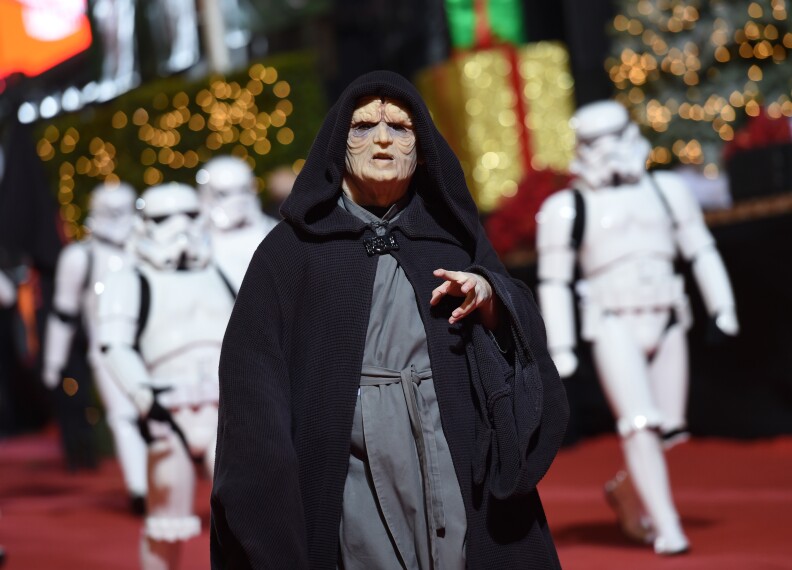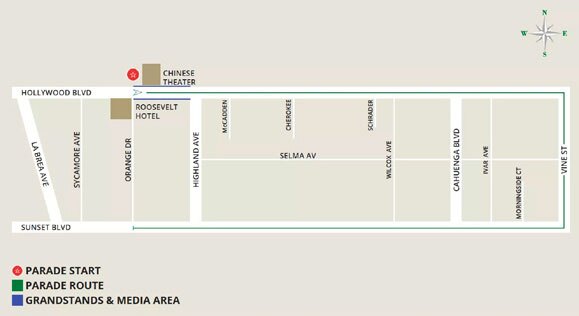With our free press under threat and federal funding for public media gone, your support matters more than ever. Help keep the LAist newsroom strong, become a monthly member or increase your support today during our fall member drive.
A Brief History Of The Hollywood Christmas Parade (And How To Avoid Its Traffic)

The Hollywood Christmas Parade is one of Hollywood's oldest traditions, with roots dating back to the 1920s. It's a chance for wonderment. Or to forget it's happening and get stuck while trying to cross Hollywood Boulevard. Held the Sunday after Thanksgiving (except for last year due to the pandemic), the parade shuts down stretches of Hollywood and Sunset boulevards to make way for a line of floats, balloons, celebrities and performers.

The History
You can thank (or blame) Colonel Harry Blaine, head of the Hollywood Chamber of Commerce, for the Christmas parade. For the first edition, in 1928, he wanted to capitalize on the success of the Macy's Thanksgiving Day Parade and another Christmas parade being held in downtown Los Angeles, according to the Hollywood Property Owners Alliance.

That first year, the shopping district along Hollywood Boulevard was turned into Santa Claus Lane, with a parade featuring Santa, accompanied by actress Jeannette Loff, heading down the street in a reindeer-drawn sleigh with a few floats. In the midst of Prohibition, this might've qualified as a wild night on the town.
That year, the parade then daily during the Christmas season, with a different movie star each night, like those daily Disneyland parades but to promote a variety of businesses.

In 1931, the Hollywood Chamber of Commerce turned it into an annual celebration. Celebrities would become a hallmark of the parade, with studios putting their stars on the route to help generate publicity. Everyone from Bette Davis to Bob Hope participated.
By the mid-1930s, the parade had grown thanks to the addition of horseback riders, drill teams and marching bands. Gene Autry credited his 1946 appearance in the parade with inspiring him to write "Here Comes Santa Claus."

The parade has run almost continuously since then. It was suspended between 1942 and 1944 due to World War II, before reopening in 1945 with record attendance to a festivity-starved post-war crowd.
The parade appeared in 1951's Hollywood Story, with a scene filmed in the midst of the parade outside Grauman's Chinese Theatre.

Electrified Christmas trees once lined the parade but by 1956, fire marshals ruled that the wiring was unsafe. Crowds remained huge, with one estimate at the time saying that nearly a million people lined Hollywood Boulevard.
In 1978, the event was renamed the Hollywood Christmas Parade and moved from Thanksgiving Eve to the Sunday after Thanksgiving.

The parade ran into trouble in the early 2000s as viewership and attendance declined. Local networks stopped broadcasting the parade due to low ratings and rising production costs.
In 2007, the Hollywood Chamber of Commerce decided to cancel the parade. But after protests and public disapproval, the city replaced the parade with the Hollywood Santa Parade. By 2009, the classic name was back, with the event being run by Associated Television.
"It's hard to believe it's been 10 years since we first decided to take on the parade," Associated Television's Jim Romanovich said at a parade press conference. "No one was really sure what to expect. Would it be accepted? Could we bring back the magic and the glory again?"
You can find out in person this Sunday, along with watching the televised broadcast.

The Traffic
Traffic has long been an issue with the Hollywood Christmas Parade. A caption on a 1964 photo from the L.A. Public Library's collection notes that traffic in and out of Hollywood was snarled until nearly midnight due to the event. Those issues still happen every year.
The parade, which follows a giant half-circle route, closes sections of Hollywood Boulevard, Sunset Boulevard and Vine Street.

The best way to avoid traffic, both for those attending and those trying to make their way around the parade, is to take the Metro and plan ahead.
"If you can avoid the area, please avoid the area," L.A. Department of Transportation parking chief Devon Farfan said at a press conference in 2019.

If you have to drive into Hollywood on Sunday night, give yourself extra time to get there. If you're attending the parade itself, consider parking several blocks away and walking to the event. Parade officials suggest parking in the Hollywood and Highland shopping complex or other nearby public lots. Consider carpooling.
Parking enforcement officers will be out in force before, during and after the parade, so read signs carefully.

The Tradition
Over the years, the parade has weathered the storms (usually metaphorical — this is Southern California), to remain a Hollywood tradition.
"It's the parade we all grew up with, and now it's the parade that your kids will one day say that they grew up with as well," Romanovich said.

Steve Moyer, a PR rep for the parade, credits its success to its family-friendly atmosphere and the power of tradition.
"The pageantry, glitz and glamour of the parade are things that people around the world equate with Tinseltown,"
Moyer said in an email. He added that his favorite part of the evening is seeing the expressions on kids' faces as the parade passes by.
"Please come and bring your whole family, as this is the World Series of Christmas parades. This is a great event to get together, and remember community, and remember family," Romanovich said.

This year, the Hollywood Christmas Parade will be held on Sunday, Nov. 28 at 6 p.m. It will be hosted by Erik Estrada, Laura McKenzie, Dean Cain and Montel Williams. The Grand Marshal is comedian and actress Sheryl Underwood, who co-hosts The Talk. If you can't attend in person, it will be broadcast on The CW Network, along with "other outlets to be announced."
You can line up along Hollywood Boulevard and watch the parade for free. There are also a handful of VIP seats in the grandstand available for purchase ($85/person).

At LAist, we believe in journalism without censorship and the right of a free press to speak truth to those in power. Our hard-hitting watchdog reporting on local government, climate, and the ongoing housing and homelessness crisis is trustworthy, independent and freely accessible to everyone thanks to the support of readers like you.
But the game has changed: Congress voted to eliminate funding for public media across the country. Here at LAist that means a loss of $1.7 million in our budget every year. We want to assure you that despite growing threats to free press and free speech, LAist will remain a voice you know and trust. Speaking frankly, the amount of reader support we receive will help determine how strong of a newsroom we are going forward to cover the important news in our community.
We’re asking you to stand up for independent reporting that will not be silenced. With more individuals like you supporting this public service, we can continue to provide essential coverage for Southern Californians that you can’t find anywhere else. Become a monthly member today to help sustain this mission.
Thank you for your generous support and belief in the value of independent news.

-
A tort claim obtained by LAist via a public records request alleges the Anaheim procurement department lacks basic contracting procedures and oversight.
-
Flauta, taquito, tacos dorados? Whatever they’re called, they’re golden, crispy and delicious.
-
If California redistricts, the conservative beach town that banned LGBTQ Pride flags on city property would get a gay, progressive Democrat in Congress.
-
Most survivors of January's fires face a massive gap in the money they need to rebuild, and funding to help is moving too slowly or nonexistent.
-
Kevin Lacy has an obsession with documenting California’s forgotten and decaying places.
-
Restaurants share resources in the food hall in West Adams as Los Angeles reckons with increasing restaurant closures.







